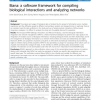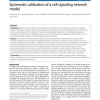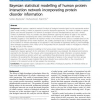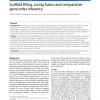BMCBI
2010
13 years 11 months ago
2010
Background: The analysis and usage of biological data is hindered by the spread of information across multiple repositories and the difficulties posed by different nomenclature sy...
BMCBI
2010
13 years 11 months ago
2010
BMCBI
2010
13 years 11 months ago
2010
Background: DNA signatures are distinct short nucleotide sequences that provide valuable information that is used for various purposes, such as the design of Polymerase Chain Reac...
BMCBI
2010
13 years 11 months ago
2010
Background: Mathematical modeling is being applied to increasingly complex biological systems and datasets; however, the process of analyzing and calibrating against experimental ...
BMCBI
2010
13 years 11 months ago
2010
Background: Identifying candidate genes in genetic networks is important for understanding regulation and biological function. Large gene expression datasets contain relevant info...
BMCBI
2010
13 years 11 months ago
2010
Background: Partitioning of a protein into structural components, known as domains, is an important initial step in protein classification and for functional and evolutionary stud...
BMCBI
2010
13 years 11 months ago
2010
Background: We present a statistical method of analysis of biological networks based on the exponential random graph model, namely p2-model, as opposed to previous descriptive app...
BMCBI
2010
13 years 11 months ago
2010
Background: Oligonucleotide arrays have become one of the most widely used high-throughput tools in biology. Due to their sensitivity to experimental conditions, normalization is ...
BMCBI
2010
13 years 11 months ago
2010
Background: There has been a trend in increasing the phylogenetic scope of genome sequencing without finishing the sequence of the genome. Increasing numbers of genomes are being ...
BMCBI
2010
13 years 11 months ago
2010
Background: Sequence alignments form part of many investigations in molecular biology, including the determination of phylogenetic relationships, the prediction of protein structu...





